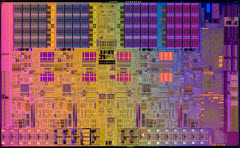Intel shakes up mid-range CPUs with Lynnfield Core i5 750, Core i7 860 and Core i7 870

Intel by releasing three new Lynnfield-based Core i5 and i7 parts has significantly shaken up the mid-range of the CPU universe.

Until now ...
Today sees Intel release three new Lynnfield-based parts whose sole purpose is to dominate the mid-range.
So, how do the new Lynnfield-based CPUs differ from the existing Bloomfield-based Core i7 parts? Well, the first thing to bear in mind is that the new Lynnfield parts are cut down/cheaper/mid-range/not as expensive/not as high end/not as extreme derivatives of the Bloomfield parts. In order to come up with a cheaper Core ix part, what Intel has done is thrown out some of the "extreme" bits of the Bloomfield Core i7's.
A lot of similarities remain. Both Bloomfield and Lynnfield parts have around 700 million transistors, based on 45nm architecture, use a monolithic quad-core design, feature 1MB L2 and 8MB of shared L3 cache, includes SSE4.2 support and HyperThreading (not on the Core i5) to name but a few commonalities.
So, what's different?
Socket compatibility
The Bloomfield Core i7 parts fit the LGA1366 socket using the X58 chipset, but the Lynnfield CPUs have a lower pin-count and fit into an LGA1156 socket and make use of a P55 chipset. The different socket means that there's no upgrade path between Lynnfield and Bloomfield without carrying out a major upgrade.
DMI rather than QPI
Lynnfield parts continue to use the lower-bandwidth DMI (Direct Memory Interface) rather than the higher-bandwidth QPI found in Bloomfield parts.
Dual-channel rather than triple-channel
The new Lynnfield parts are dual-channel parts, leaving the higher-bandwidth triple-channel memory controller for Bloomfield CPUs.
Better Turbo Boost
Not everything about the Lynnfield parts is a downgrade from the Bloomfield silicon. A good example of this is the Turbo Boost feature. While Bloomfield CPUs could only boost the clock speed across all four cores by one multiplier step (133MHz) or two multiplier steps (266MHz) for apps using one or two cores, Lynnfield parts can boost the clock by four multiplier steps across all four cores (533MHz), and five steps (666MHz) for apps using a single core (except for the i5 750, which can only go up four steps total -this part also doesn't feature HyperThreading ). That's a massive improvement over Bloomfield. parts.
Confusion ...
OK, time to clear up the fog a little. Socket 1156 and Socket 1366 aren't interchangeable, so if you buy based on socket, you're safe. However, Intel has muddied the water by labeling 8xx series parts Core i7 because these parts, unlike existing Core i7 parts, are Socket 1156 processors. Intel is using i7 as an indicator that the processors features HyperThreading (HT) and i5 to indicate that it doesn't have HT, but this is going to lead to all sorts of hassles for users, especially upgraders.
The new parts
Here's some details on the three new parts:
- i5 750 - 2.66GHz - $196
- i7 860 - 2.80GHz - $284
- i7 870 - 2.93GHz - $562